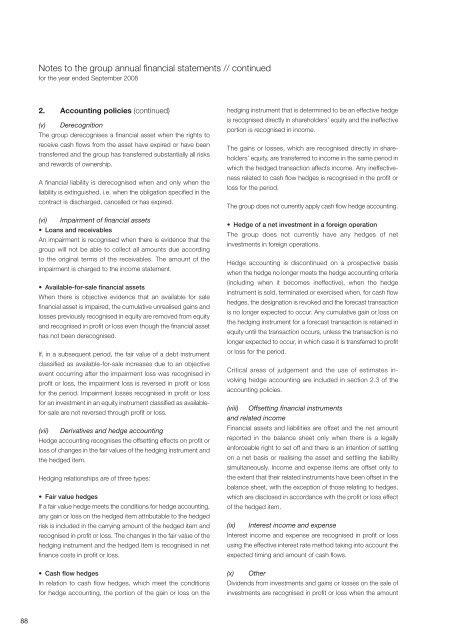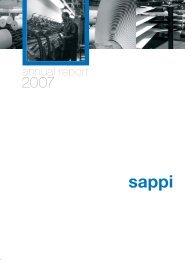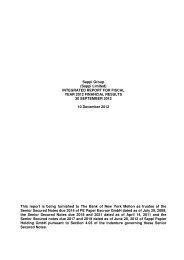2008 Annual report - Sappi
2008 Annual report - Sappi
2008 Annual report - Sappi
You also want an ePaper? Increase the reach of your titles
YUMPU automatically turns print PDFs into web optimized ePapers that Google loves.
Notes to the group annual financial statements // continued<br />
for the year ended September <strong>2008</strong><br />
2. Accounting policies (continued)<br />
(v) Derecognition<br />
The group derecognises a financial asset when the rights to<br />
receive cash flows from the asset have expired or have been<br />
transferred and the group has transferred substantially all risks<br />
and rewards of ownership.<br />
A financial liability is derecognised when and only when the<br />
liability is extinguished, i.e. when the obligation specified in the<br />
contract is discharged, cancelled or has expired.<br />
(vi) Impairment of financial assets<br />
• Loans and receivables<br />
An impairment is recognised when there is evidence that the<br />
group will not be able to collect all amounts due according<br />
to the original terms of the receivables. The amount of the<br />
impairment is charged to the income statement.<br />
• Available-for-sale financial assets<br />
When there is objective evidence that an available for sale<br />
financial asset is impaired, the cumulative unrealised gains and<br />
losses previously recognised in equity are removed from equity<br />
and recognised in profit or loss even though the financial asset<br />
has not been derecognised.<br />
If, in a subsequent period, the fair value of a debt instrument<br />
classified as available-for-sale increases due to an objective<br />
event occurring after the impairment loss was recognised in<br />
profit or loss, the impairment loss is reversed in profit or loss<br />
for the period. Impairment losses recognised in profit or loss<br />
for an investment in an equity instrument classified as availablefor-sale<br />
are not reversed through profit or loss.<br />
(vii) Derivatives and hedge accounting<br />
Hedge accounting recognises the offsetting effects on profit or<br />
loss of changes in the fair values of the hedging instrument and<br />
the hedged item.<br />
Hedging relationships are of three types:<br />
• Fair value hedges<br />
If a fair value hedge meets the conditions for hedge accounting,<br />
any gain or loss on the hedged item attributable to the hedged<br />
risk is included in the carrying amount of the hedged item and<br />
recognised in profit or loss. The changes in the fair value of the<br />
hedging instrument and the hedged item is recognised in net<br />
finance costs in profit or loss.<br />
hedging instrument that is determined to be an effective hedge<br />
is recognised directly in shareholders’ equity and the ineffective<br />
portion is recognised in income.<br />
The gains or losses, which are recognised directly in share -<br />
holders’ equity, are transferred to income in the same period in<br />
which the hedged transaction affects income. Any ineffective -<br />
ness related to cash flow hedges is recognised in the profit or<br />
loss for the period.<br />
The group does not currently apply cash flow hedge accounting.<br />
• Hedge of a net investment in a foreign operation<br />
The group does not currently have any hedges of net<br />
investments in foreign operations.<br />
Hedge accounting is discontinued on a prospective basis<br />
when the hedge no longer meets the hedge accounting criteria<br />
(including when it becomes ineffective), when the hedge<br />
instrument is sold, terminated or exercised when, for cash flow<br />
hedges, the designation is revoked and the forecast transaction<br />
is no longer expected to occur. Any cumulative gain or loss on<br />
the hedging instrument for a forecast transaction is retained in<br />
equity until the transaction occurs, unless the transaction is no<br />
longer expected to occur, in which case it is transferred to profit<br />
or loss for the period.<br />
Critical areas of judgement and the use of estimates involving<br />
hedge accounting are included in section 2.3 of the<br />
accounting policies.<br />
(viii) Offsetting financial instruments<br />
and related income<br />
Financial assets and liabilities are offset and the net amount<br />
<strong>report</strong>ed in the balance sheet only when there is a legally<br />
enforceable right to set off and there is an intention of settling<br />
on a net basis or realising the asset and settling the liability<br />
simultaneously. Income and expense items are offset only to<br />
the extent that their related instruments have been offset in the<br />
balance sheet, with the exception of those relating to hedges,<br />
which are disclosed in accordance with the profit or loss effect<br />
of the hedged item.<br />
(ix) Interest income and expense<br />
Interest income and expense are recognised in profit or loss<br />
using the effective interest rate method taking into account the<br />
expected timing and amount of cash flows.<br />
• Cash flow hedges<br />
In relation to cash flow hedges, which meet the conditions<br />
for hedge accounting, the portion of the gain or loss on the<br />
(x) Other<br />
Dividends from investments and gains or losses on the sale of<br />
investments are recognised in profit or loss when the amount<br />
88
















